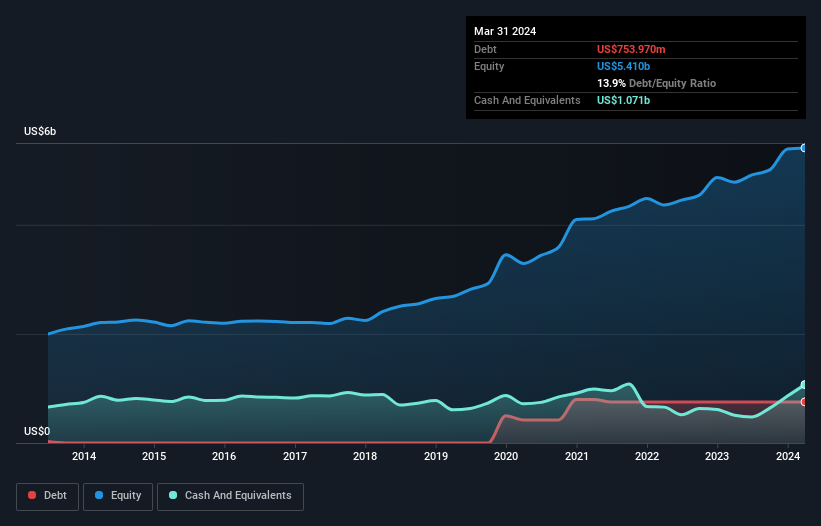
Some say volatility, rather than debt, is the best way to think about risk as an investor, but Warren Buffett famously said that 'Volatility is far from synonymous with risk.' So it might be obvious that you need to consider debt, when you think about how risky any given stock is, because too much debt can sink a company. We note that ANSYS, Inc. (NASDAQ:ANSS) does have debt on its balance sheet. But is this debt a concern to shareholders?
When Is Debt Dangerous?
Debt assists a business until the business has trouble paying it off, either with new capital or with free cash flow. If things get really bad, the lenders can take control of the business. However, a more usual (but still expensive) situation is where a company must dilute shareholders at a cheap share price simply to get debt under control. Having said that, the most common situation is where a company manages its debt reasonably well - and to its own advantage. The first thing to do when considering how much debt a business uses is to look at its cash and debt together.
See our latest analysis for ANSYS
How Much Debt Does ANSYS Carry?
The chart below, which you can click on for greater detail, shows that ANSYS had US$754.0m in debt in March 2024; about the same as the year before. However, it does have US$1.07b in cash offsetting this, leading to net cash of US$316.6m.

How Healthy Is ANSYS' Balance Sheet?
Zooming in on the latest balance sheet data, we can see that ANSYS had liabilities of US$706.6m due within 12 months and liabilities of US$1.03b due beyond that. Offsetting these obligations, it had cash of US$1.07b as well as receivables valued at US$836.3m due within 12 months. So it actually has US$166.1m more liquid assets than total liabilities.
Having regard to ANSYS' size, it seems that its liquid assets are well balanced with its total liabilities. So while it's hard to imagine that the US$28.5b company is struggling for cash, we still think it's worth monitoring its balance sheet. Succinctly put, ANSYS boasts net cash, so it's fair to say it does not have a heavy debt load!
On the other hand, ANSYS's EBIT dived 15%, over the last year. We think hat kind of performance, if repeated frequently, could well lead to difficulties for the stock. There's no doubt that we learn most about debt from the balance sheet. But ultimately the future profitability of the business will decide if ANSYS can strengthen its balance sheet over time. So if you're focused on the future you can check out this free report showing analyst profit forecasts.
But our final consideration is also important, because a company cannot pay debt with paper profits; it needs cold hard cash. ANSYS may have net cash on the balance sheet, but it is still interesting to look at how well the business converts its earnings before interest and tax (EBIT) to free cash flow, because that will influence both its need for, and its capacity to manage debt. Happily for any shareholders, ANSYS actually produced more free cash flow than EBIT over the last three years. There's nothing better than incoming cash when it comes to staying in your lenders' good graces.
Summing Up
While it is always sensible to investigate a company's debt, in this case ANSYS has US$316.6m in net cash and a decent-looking balance sheet. The cherry on top was that in converted 112% of that EBIT to free cash flow, bringing in US$710m. So we are not troubled with ANSYS's debt use. Over time, share prices tend to follow earnings per share, so if you're interested in ANSYS, you may well want to click here to check an interactive graph of its earnings per share history.
If, after all that, you're more interested in a fast growing company with a rock-solid balance sheet, then check out our list of net cash growth stocks without delay.
New: Manage All Your Stock Portfolios in One Place
We've created the ultimate portfolio companion for stock investors, and it's free.
• Connect an unlimited number of Portfolios and see your total in one currency
• Be alerted to new Warning Signs or Risks via email or mobile
• Track the Fair Value of your stocks
Have feedback on this article? Concerned about the content? Get in touch with us directly. Alternatively, email editorial-team (at) simplywallst.com.
This article by Simply Wall St is general in nature. We provide commentary based on historical data and analyst forecasts only using an unbiased methodology and our articles are not intended to be financial advice. It does not constitute a recommendation to buy or sell any stock, and does not take account of your objectives, or your financial situation. We aim to bring you long-term focused analysis driven by fundamental data. Note that our analysis may not factor in the latest price-sensitive company announcements or qualitative material. Simply Wall St has no position in any stocks mentioned.
About NasdaqGS:ANSS
ANSYS
Develops and markets engineering simulation software and services for engineers, designers, researchers, and students.
Flawless balance sheet with proven track record.
Similar Companies
Market Insights
Community Narratives



